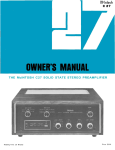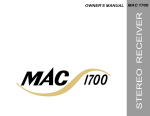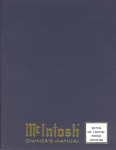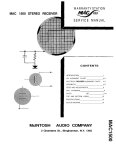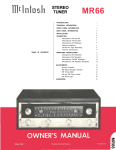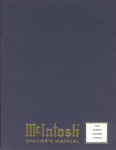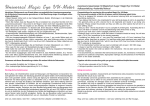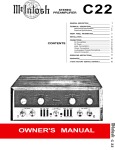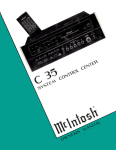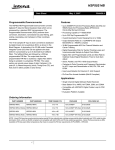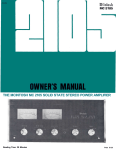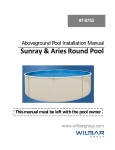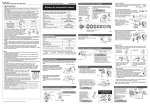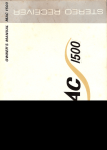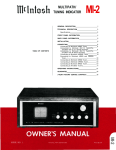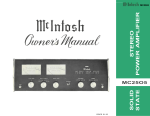Download McIntosh MR 71 Operating instructions
Transcript
FM STEREO TUNER MR 71 TABLE OF CONTENTS CONTENTS INTRODUCTION 1 TECHNICAL DESCRIPTION 2 FRONT PANEL INFORMATION 6 BACK PANEL INFORMATION 8 INSTALLATION 8 CONNECTING Audio Outputs Stereophonic FM Multiplex Monophonic FM Remote Amplifiers Off-The-Air Recording Antenna Connections 9 9 9 9 9 9 9 OPERATING INSTRUCTIONS Stereophonic FM Multiplex Monophonic FM 11 11 11 ADJUSTMENTS Muting Threshold Dial Panel Lights Output Adjust 12 12 12 12 GUARANTEE 13 OWNER'S MANUAL MR71 THANK YOU Judging from the stereo equipment you own, you rank high among discriminating music listeners. You are probably no freshman when it comes to stereo. Never-the-less we ask you to read and carefully follow these instructions to insure a successful partnership between you and your new stereo equipment. You now have "THE BEST." Used properly you are in for thousands of hours of musical enjoyment. If you are in a hurry, read page 3 first. This gives you a brief outline of what each control and indicator does. Reading time for this manual is 30 minutes. This is time well spent. MR 71 FM STEREO TUNER INTRODUCTION The Mclntosh MR 71 is a precision engineered, highly sensitive FM Multiplex Tuner. The research staff of Mclntosh Laboratory has developed five new tuner circuit improvements for the MR 71. 1. Automatic stereo-mono switching that is "clickless" and completely electronic. (Patent applied for.) 2. Multipath indicator to eliminate multipath reception by showing when your antenna is rotated to the correct position for minimum multipath distortion. 3. Double tuned input circuits before the first R.F. amplifier to reduce spurious responses. 4. New D'Arsonval movement meters of increased sensitivity which do not need zero setting adjustments. 5. A new computer designed filter to reduce noise from stations broadcasting subcarrier auxiliary music services. No other tuner uses such a filter. The MR 71 also uses the exclusive Mclntosh PANLOC method of installation. The PANLOC system gives you absolute ease of installation, operation, and maintenance. PANLOC is the first professional installation technique to be used on stereo instruments. In the PANLOC system a metal shelf is mounted first. The tuner slides into position on this shelf. Depressing the PANLOC buttons on the front panel locks the tuner firmly into place for normal operation. To unlock the tuner depress the PANLOC buttons a second time. The tuner can now slide from the front panel. The tuner will lock into this position, preventing accidental release of the tuner from the installation. Depressing the holding latches allows the tuner to be taken out of the PANLOC shelf or to slide back into position against the mounting panel. The finest possible reception of FM monophonic and FM multiplex stereophonic broadcasts is assured by the Mclntosh MR 71 tuner. Once you have enjoyed the outstanding performance of the MR 71, you will understand why Mclntosh products have earned their reputation as "THE BEST." Your Mclntosh MR 71 tuner will give you years of the finest possible FM reception, and will be a valued part of your home music system. 1 TECHNICAL DESCRIPTION The MR 71 tuner has a 6DS4 high-grain Nuvistor for the first RF amplifier. The Nuvistor (triode) operates into a second triode tube to form a cascade amplifier. Careful design of the operating characteristics allows the cascade amplifier to handle a wide dynamic range of signals with excellent signal-tonoise ratio. A double-tuned RF input circuit combined with the Nuvistor-tube cascade amplifier reduces spurious signals to an extremely low value. Sensitivity is increased to the highest possible rating, while still retaining high selectivity. A newly developed Automatic Frequency Control (AFC) circuit greatly simplifies tuning. As the tuning knob is moved, the AFC circuit automatically cuts off for sharpest tuning. After the station is tuned in, the AFC circuit gradually comes into operation over a 3 second interval. The AFC action automatically brings the tuning to minimum distortion. This automatic tuning repeats its action each time the tuning dial is moved to a new station. The amount of AFC action is fully adjustable with a front panel control. The AFC circuit is unique. It uses a silicon diode in place of a conventional tube. The silicon diode improves the overall AFC performance. It is unaffected by temperature changes. It has no warm-up drift and eliminates the chance of tube filament hum. A temperature-compensated narrow band detector supplies operating signals to the AFC circuit. This insures positive AFC action. The narrow band detector also operates the FM tuning meter amplifier and the ultrasonic muting circuit. The Mclntosh developed ultrasonic muting circuit automatically suppresses all interstation noise, including the noises usually heard tuning in and out of a station. Weak or distant stations that can't override the background noise and interference are suppressed by the muting. A front panel switch allows muting to be cut off for listening to weak and noisy stations. A back panel adjust control is factory set to the correct muting threshold level. 2 The mixer output is amplified through five intermediate frequency stages with flattopped highly selective response curves. The IF transformers have wide band response with maximum adjacent channel rejection. Construction of the IF transformers assures electrical stability and resistance to mechanical shock and vibration. More than adequate gain is provided to operate both limiters on the weakest signals. Two complete limiters are used for the best possible signal-to-noise ratio. A separate wide band detector handles only audio frequencies for low distortion and wide frequency response. Both the RF and IF circuits are completely shielded in excess of FCC requirements for suppression of radiation of the FM oscillator and IF frequencies. The MR 71 multiplex decoder uses a Mclntosh developed detector. The advantage of this circuit is the elimination of critical adjustments necessary with commonly used multiplex matrixing methods. The L-R (left minus right) stereo sidebands are detected. Then automatically combined with the L+R main carrier signal. The left and right channel signals are then produced with excellent separation. A temperature stabilized 19KC amplifier locks in a highly stable 38KC synchronous oscillator. This method gives exceptional noise immunity. Balanced detectors cancel the 38KC signal components in the output, providing low distortion and reduced susceptibility to spurious signals. Tape recording interference is minimized by this method. A highly selective computer designed filter reduces noise from stations broadcasting auxiliary music services. The filter reduces the frequency band from 63-74KC approximately 50db. The filter response slope is 275db per octave. The noise is eliminated without affecting normal program material. The MR 71 has a multiplex stereo indicator which lights when the dial pointer crosses a station broadcasting multiplex stereo. A unique circuit using a transistor operates the Your Mclntosh MR71 tuner will give you many years of pleasant and satisfactory performance. If you have any questions concerning the operation or maintenance of this tuner please contact: Customer Service Mclntosh Laboratory Inc. 2 Chambers Street Binghamton, New York Our telephone number is 723-5491. The direct dial area code is 607. GUARANTEE Mclntosh Laboratory Incorporated guarantees this equipment to perform as advertised. We also guarantee the mechanical and electrical workmanship and components of this equipment to be free of defects for a period of 90 days from date of purchase, This guarantee does not extend to components damaged by improper use nor does it extend to damage incurred during transportation to and from Mclntosh Laboratory, Inc. 3-YEAR FACTORY SERVICE CONTRACT An application for a FREE 3-YEAR FACTORY SERVICE CONTRACT is included in the pocket in the back cover of this manual. The FREE 3-YEAR FACTORY SERVICE CONTRACT will be issued by Mclntosh Laboratory upon receipt of the completely filed out application form. The term of this contract is de- fined in the 3-year factory service contract. If the application is not mailed to Mclntosh Laboratory, only the services offered under the standard 90-day guarantee will apply on this equipment. TAKE ADVANTAGE OF 3 YEARS OF FREE FACTORY SERVICE BY FILLING IN THE APPLICATION NOW. Design subject to change without notice. 13 MPX stereo indicator lamp. The transistor is controlled by a noise-rejecting differential detecting bridge circuit. The circuit discriminates between noise and the 19KC multiplex pilot signal. The indicator will light only on the 19KC signal present in a multiplex stereo broadcast. The MR 71 uses a new Mclntosh developed automatic mono-stereo switching circuit. (Pat. Pend.) The switching is electronic without switching clicks or transients. The circuit switches smoothly and silently when the 19KC multiplex carrier is present. The multipath signal indicator on the tuning dial is an electron ray tube. This is an exclusive Mclntosh development. Multipath signal reception causes moderate to severe distortion and poor stereo channel separation. By knowing the presence of multipath reception, a directional FM antenna may be rotated to reduce or eliminate the multipath signal. The MR 71 multipath indicator shows if there are multipath signals present by rapid fluctuation of the electron ray beams. With the antenna correctly positioned, the indicator beams remain relatively steady, showing that multipath distortion has been eliminated. Two pairs of audio output jacks are on the back panel. One pair of jacks is controlled only by the front panel volume control. The other pair of jacks is controlled only by the back panel output adjust controls. Two stage feedback type preamplifiers on both channels provide low impedance outputs. More than sufficient output volume is available to feed power amplifiers as well as preamplifiers. A new type of mechanical tuning assembly gives the MR 71 extremely smooth flywheel tuning action. The tuning capacitor is driven directly, and in turn drives the pointer. Backlash is eliminated with this design. A teflon lined pointer carriage and nylon pulleys reduce friction and wear to give an unusually smooth and quiet dial action. IF YOU ARE IN A HURRY Turn antenna so the eye is steady. Adjust to desired volume. Tune for Max. reading. Power off. Use stereo-auto position: will switch automatically from stereo to mono. Will light only on stations broadcasting MPX stereo, Tuning . . . select desired station Tune for center of black area. In . . . eliminates interstation noise. Out . . . use to receive weak stations. Continuously variable, use Max. position for MPX reception. 3 SPECIFICATIONS Useable Sensitivity 2.5 microvolts at 100% modulation (±75KC deviation) for less than 3% total noise and harmonic distortion in accordance with IHF standards. Audio Frequency Response Within ½db from 20 to 20,000 cycles. Distortion Lessthan0.5%at 100% modulation ±75KC deviation Capture Ratio 1.5db at 100% modulation. Muting IF injected ultrasonic muting: at least 60db noise reduction between stations. Oscillator Drift Less than 25KC with AFC disabled; negligible with AFC in operation. Image Rejection Better than 80db at 90MC; better than 70db at 105MC. Hum Better than 70db below 100% modulation. Output Approximately 2.5 volts; low impedance. Antenna Inputs 300 ohms balanced; 75 ohms unbalanced. RF Amplifier Cascode with 6DS4 Nuvistor in first stage. IF Stages Five, with 200KC bandwidth, flat top response. Limiters Two. Radiation Substantially below FCC requirements. Multiplex Channel Separation Better than 30db at 1000 cycles. Multiplex Filter Greater than 48db suppression of 19KC pilot and 38KC carrier. Multiplex Indicator Front panel multiplex stereo light activated by 19KC carrier-only. Multiplex Type Peak-detecting, self matrixing detector. SCA Filter 50db down at 67KC to 74KC 275db per octave slope. 4 Automatic Mono-Stereo Switch An exclusive Mclntosh development; allelectronic automatic mono-stereo switching circuit. (Pat. Pend.). Tube and Semiconductor Complement 1-6DS4 Nuvistor, 1st RF. 1-12AT7, 2nd RF and Mixer. 1-6BN4A, Oscillator. 1-6AU6, 1st IF. 1-6AU6, 2nd IF. 1-6AU6, 3rd IF. 1-6AU6, 4th IF and 1st Limiter. 1-6CS6, 5th IF 2nd Limiter and Muting. 1—6BN8, Muting Amplifier, Muting Detector, AVC Clamper. 2-6BL8, Left and Right, 1st and 2nd Audio Amplifiers. 1-6U8, MPX Amplifier, MPX Indicator Control. 1-6HU6/EM87 Multipath Indicator. 1-12AU7, MPX Oscillator. 1-ST2-275, Voltage Reference. 1-MA113 (Transistor), MPX Indicator Lamp Switch. 2-1N542 Diodes, Wide Band Discriminator. 2—1N542 Diodes, Narrow Band Discriminator. 4-1N542 Diodes, Balanced MPX Detector. 2-1N542 Diodes, Balanced Detector for MPX Indicator. 2—Selenium Rectifiers, High Voltage Power Supply. 1-No. 1850 Lamp, MPX Indicator. Power Consumption 70 watts, 105 to 125 volts, 50 to 60 cycles. Dimensions Front Panel; 16 inches wide by 57/16 inches high; chassis (including PANLOC shelf) 15 inches wide by 5 inches high by 13 inches deep, including connectors; clearance in front of mounting panel including knobs. 1½ inches. Weight Chassis only, 27 pounds. In shipping carton, 37 pounds. 5 BLOCK DIAGRAM MR 71 FRONT PANEL INFORMATION TUNING DIAL SCALES The MR 71 has two dial scales, the 88 to 108 scale marked in megacycles and the 0-100 logging scale. The dial scale marked in megacycles indicates the positions of FM stations in the 88 to 108 megacycle band. The logging scale with linear divisions from 0-100 is located directly beneath the 88 to 108 scale. The logging scale can be used to accurately retune any station. You may find it easier to keep a record of your favorite stations by use of the logging scale. INDICATORS The MR 71 has four indicators on the dial panel: MULTIPATH indicator, SIGNAL STRENGTH indicator, STEREO indicator, and the TUNING indicator. MULTIPATH INDICATOR The MR 71 MULTIPATH indicator is an exclusive Mclntosh development. The MR 71 MULTIPATH indicator makes it possible to improve FM reception with precise FM antenna positioning. Reduce noise due to multipath reception. Reduce distortion due to multipath reception. Improve stereo separation and the accuracy of your STEREO INDICATOR by reducing multipath reception. The MR 71 MULTIPATH INDICATOR shows distortion from multipath signal reception. Multipath reception causes the two beams on the indicator to fluctuate rapidly. When the antenna is rotated to the correct position, the indicator beams will remain steady. The 6 directional antenna is picking up only the desired signal and rejecting the reflected multipath signals. In some locations, it is possible that the best reception will occur on a strong reflected signal rather than the direct signal. When you tune to a different station, the multipath indicator will tell you if multipath is present. Multipath is independent of signal strength. STEREO INDICATOR The stereo indicator will light when the dial pointer crosses a station broadcasting multiplex stereo. The special circuit used will light ONLY on the 19KC multiplex carrier. The indicator will not light on noise pulses or interference. TUNING INDICATOR An FM station is correctly tuned when the indicator is in the black area of the tuning indicator. The action of the TUNING indicator is independent of station signal strength. VOLUME Controls volume level when the tuner is connected to the pair of jacks marked FRONT PANEL CONTROLLED. MODE SELECTOR POWER OFF brings the tuning to minimum distortion. The AFC action repeats itself each time the tuning dial is moved to a different station. The amount of AFC action is adjustable with the AUTO FREQ. CONTROL. Full left (MIN) position of the control cuts off AFC action. Full right (MAX) position gives maximum AFC action. MONO Normally, the best tuning occurs with the AUTO FREQ. CONTROL set at or near MAX position. If several stations are very close together on the dial, or if a desired station is very close to a much stronger station, a lower AFC setting is usually needed for best tuning. Provides monophonic FM at both pairs of left and right channel audio output jacks. MUTING Turns off the tuner AC power and the AC outlet on the tuner back panel. STEREO AUTO The STEREO AUTO position provides both monophonic FM and FM multiplex stereo at the left and right channel audio output jacks. Assume you have the MR 71 MODE SELECTOR in the STEREO AUTO position. You are listening to a station broadcasting FM monophonic. The station switches to MPX stereo broadcast. The MULTIPLEX indicator will light. The MR 71 will automatically switch to FM multiplex stereo operation. If mono broadcasting is resumed the MR 71 will automatically switch to FM monophonic. AUTO FREQ. CONTROL OUT OUT—This position turns off the muting to allow conventional tuning with interstation noise present. Use this setting to listen to weak or distant stations that have noise or interference. IN—This position turns on the muting circuit. Muting suppresses all background hiss and noise usually heard when tuning between stations. Weak or distant stations that cannot override the background noise and interference are suppressed by the muting. PANLOC BUTTONS The Automatic Frequency Control (AFC) circuit makes FM tuning easier. It eliminates the possibility of tuner drift. The AFC circuit in the MR 71 is electronically delayed in its action. This is an exclusive Mclntosh development. When the tuning dial is moved, the AFC circuit is temporarily cut off. When the dial pointer comes to rest on a station the AFC gradually comes into operation. This takes three seconds. The AFC automatically At the bottom of the front corners are the PANLOC buttons. After a tuner is installed on the PANLOC shelf, depressing the PANLOC buttons will lock the tuner firmly in position. Depressing the PANLOC buttons a second time (as with a ball-point pen> will release the tuner. The tuner can then be slid forward to the inspection and adjustment position. The PANLOC system gives you absolute ease of installation, operation and maintenance. 7 BACK PANEL INFORMATION TP 2 fier which has its own master volume control. Test point TP 2 is provided for tuner circuit alignment. It is also used in conjunction with the Mclntosh Ml 2 or Ml 3. The right hand pair of AUDIO OUTPUT jacks provides audio signal controlled by the MR 71 front panel VOLUME control. Use these output jacks to connect to external power amplifier, tape recorders, or any equipment which requires continuous front panel control of tuner output volume. OUTPUT ADJ This dual concentric control adjusts the output volume levels at the left-hand pair of AUDIO OUTPUT JACKS. The center shaft adjusts the LEFT channel output, and the outer sleeve adjusts the RIGHT channel output. These output control settings for the left pair of jacks are not affected by the MR 71 front panel volume control. MUTING ADJ Adjust the operating threshold of the ultrasonic muting circuit. AUDIO OUTPUT-LEFT-RIGHT The left-hand pair of AUDIO OUTPUT jacks provides audio signals unaffected by the MR 71 front panel VOLUME control. The dual concentric OUTPUT ADJUST controls set the volume levels. Use these output jacks to connect the tuner to a stereo control preampli- 300 OHM-75 OHM ANTENNA Terminal for connecting FM antennas to the MR 71. 1A SLO BLO FUSE A 1 amp "Slo-Blo" fuse protects the tuner circuits. This fuse does not protect additional equipment connected to the back panel AC outlet. AC OUTLET Provides 117 volt AC power up to 350 watts maximum for additional equipment such as turntables, or other tuners. This outlet is not fused. It turns on and off with the front panel MODE SELECTOR switch. PANEL LIGHT SWITCH Adjusts the panel lights to bright or dim. INSTALLATION The Mclntosh MR 71 tuner may be installed on a table, on a shelf, in a custom built-in cabinet, or in a professional equipment rack. For best appearance in an open installation, mount the MR 71 in the attractive Mclntosh L11 cabinet. The L12 is oiled walnut. The L11 is lacquered walnut. The MR 71 tuner is installed by the new exclusive Mclntosh PANLOC method. Refer to the special PANLOC SYSTEM INSTALLATION instructions included with your MR 71. 8 Allow at least 13¾ inches behind the mounting panel for the MR 71 chassis. This includes clearance for leads and connectors. Allow inside dimensions of at least 16½ inches in width and 6 inches in height for adequate air circulation. The back of the MR 71 cabinet should be as open as possible for the best ventilation. Avoid mounting the tuner directly over a power amplifier. The heat from the amplifier may change the precision tuner calibration. Adequate ventilation will give your tuner long trouble-free life. CONNECTING AUDIO OUTPUTS Use the FIXED OUTPUT jacks (left-hand pair of jacks next to OUTPUT ADJ) to connect to a conventional control preamplifier which has its own volume control. Full tuner output is available at all times from the FIXED OUTPUT jacks. Use the FRONT PANEL CONTROLLED jacks to connect to a conventional control preamplifier when continuous front panel control of tuner volume is desired. These jacks may be used to connect to external equipment such as power amplifiers or tape recorders where control of tuner volume is necessary. There is no difference in the signal quality or output levels available at each pair of output jacks. STEREOPHONIC FM MULTIPLEX Connect a shielded cable from the tuner LEFT channel AUDIO OUTPUT jack to the control preamplifier LEFT channel tuner or auxiliary input jack. Connect a second shielded cable from the RIGHT channel tuner AUDIO output jack to the control preamplifier RIGHT channel tuner or auxiliary input jack. When the MR 71 mode selector is set to MONO or STEREO AUTO position, a monophonic broadcast will automatically be present at both left and right outputs. For a stereo broadcast set the MODE SELECTOR in the STEREO AUTO position. gram can then be fed to speaker systems apart from the main sound system. OFF THE AIR RECORDING Tape recorders or tape decks with recordplayback preamplifiers are normally connected to the Tape Output jacks on the control preamplifier. Any FM program coming through the tuner into the preamplifier can be recorded on tape. You may also connect the extra pair of tuner audio output jacks directly to the recorder inputs if desired. ANTENNA CONNECTIONS Satisfactory FM multiplex stereo reception requires 10 times as much signal as FM monophonic reception. Monophonic installations that were satisfactory with an indoor FM antenna may require an outside or directional FM antenna for satisfactory multiplex stereo reception. A good directional antenna with a rotator makes it possible to eliminate or minimize multipath distortion. The MR 71 multipath indicator shows the correct antenna position for reception with minimum multipath distortion. INDOOR FLEXIBLE FM DIPOLE MONOPHONIC FM The MR 71 can be used strictly for monophonic reception. Connect a shielded cable from either the left or right audio output jack to the monophonic control preamplifier auxiliary or tuner input jack. With the MR 71 MODE SELECTOR set to MONO, the monophonic FM signal appears at both the left and right channel AUDIO OUTPUT jacks. REMOTE AMPLIFIERS The pair of audio output jacks not being used in an installation may be connected to external or remote amplifiers. An FM pro- A convenient flexible indoor FM dipole (300 ohm) antenna is supplied with the MR 71 tuner. This antenna is easy to install. It is suitable for a good FM reception in high signal areas. Connect the two leads of the dipole antenna to the two terminals marked 300 OHM on the MR 71 back panel. The flexibility of the thin flat wire allows the dipole to be easily located behind the equipment enclosure or any position near the tuner. Open the dipole into a "T." Extend the SEE DIAGRAM NEXT PAGE 9 10 arms as straight as possible. The dipole antenna is somewhat directional. It should be positioned for best reception of the desired stations. Experimenting with the dipole position may be necessary to reduce multipath distortion on certain stations. Since it is not convenient to continually change the position of the dipole, you may have to set it for minimum multipath on your favorite station. An outdoor FM antenna is recommended for best FM reception under all conditions. In fringe areas, a highly directional FM antenna used with a rotator will give the finest possible FM reception. Rotate the antenna until it points in the direction of the station or until it receives the best possible signal. Use the multipath, signal strength and tuning indicators to position the antenna correctly. 75 OHM ANTENNA IMPORTANT Keep the dipole away from large metal objects or surfaces. They interfere with the efficiency of the antenna. OUTDOOR FM ANTENNA An unbalanced 75 ohm FM antenna can be used with the MR 71. A BNC connector is provided. Connect a Male BNC connector to the female BNC connector on the rear panel of the MR 71. OPERATING INSTRUCTIONS STEREOPHONIC FM MULTIPLEX MONOPHONIC FM 1. Turn the MODE SELECTOR to STEREO AUTO. 1. Turn the MODE SELECTOR to MONO to listen only to monophonic FM. 2. Turn MUTING to IN. 3.Turn the FM TUNING dial to the desired station. The TUNING indicator pointer should be in the black area of the tuning indicator meter. When the MPX STEREO indicator is lit, the station is broadcasting a 19KC carrier for multiplex stereo. The MR 71 will automatically switch to stereo Mode. If a station is broadcasting monophonic FM program, the MPX STEREO indicator will remain off and the tuner will automatically switch to Mono Mode. 4. Adjust the volume control to desired listening level. If the fixed audio output jacks are used, the tuner volume control will not affect volume. Note: If you wish to receive monophonic FM and have the MR 71 automatically switch to a stereo broadcast available on the same station set the MODE SELECTOR to STEREO AUTO. 2. Turn the MUTING to IN. 3. Turn the FM TUNING KNOB to the desired station. The TUNING indicator pointer should be in the black area in the center of the indicator. 4. Rotate the directional antenna for best reception as shown by the signal strength and multipath indicators. 5. Adjust the VOLUME control to desired listening level. 11 ADJUSTMENTS MUTING THRESHOLD on the tuner back panel. Set the switch to BRIGHT for maximum panel light. Set the switch to DIM for less dial light and extended lamp life. OUTPUT ADJUST The MR 71 ultrasonic muting circuit suppresses all noise between stations. It suppresses all weaker stations not strong enough to override the background noise. The muting threshold setting determines the strength of the signal which can be heard with muting in operation. The muting threshold is carefully adjusted to optimum at the factory using precision test instruments. Casual adjustment of the muting threshold is not recommended. If it is necessary to adjust the muting threshold, use the MUTING ADJ control to the RIGHT (clockwise) to lower the muting threshold. This allows weaker stations to be heard with the MUTING IN SETTING. Turn the MUTING ADJ control to the LEFT (counterclockwise) to raise the muting threshold. This allows only the more powerful stations to be heard with the MUTING IN setting. DIAL PANEL LIGHT Adjust the brightness of the dial panel lights by means of the PANEL LIGHT switch 12 The dual concentric OUTPUT ADJ controls (on the tuner back panel) adjust the output volume level of the left hand pair of AUDIO OUTPUT JACKS. The center shaft of the control adjusts the left channel output. The outer sleeve of the control adjusts the right channel output. Before making the adjustment, connect the left hand AUDIO OUTPUT jacks to the tuner inputs of the control preamplifier. Set the preamplifier selector to phono. Set the volume control to normal listening level for a stereo disc recording. Switch the preamplifier selector back to tuner. Set the MR 71 MODE SELECTOR to MONO. Tune in a local station. Tune the OUTPUT ADJ controls until the levels of both channels are equal, and equal to the volume level of the phono recording. You can now switch the preamplifier selector from the MR 71 to other program sources without readjusting the main volume control. FM STATION LOG STATION DIAL FREQ. LOG SCALE LOCATION CITY, STATE ANTENNA DIRECTION REMARKS MONO-STEREO-TIME-DATE FM STATION LOG STATION DIAL FREQ. LOG SCALE LOCATION CITY, STATE ANTENNA DIRECTION REMARKS MONO— STEREO— TIME— DATE FM STATION LOG STATION DIAL FREQ. LOG SCALE LOCATION CITY, STATE ANTENNA DIRECTION REMARKS MONO— STEREO— TIME— DATE LABORATORY INC. 2 CHAMBERS STREET, BINGHAMTON, N. Y. Made in U.S.A. Phone-Area Code 607-723-5491 038-029 BE022003 Printed in U.S.A.




















